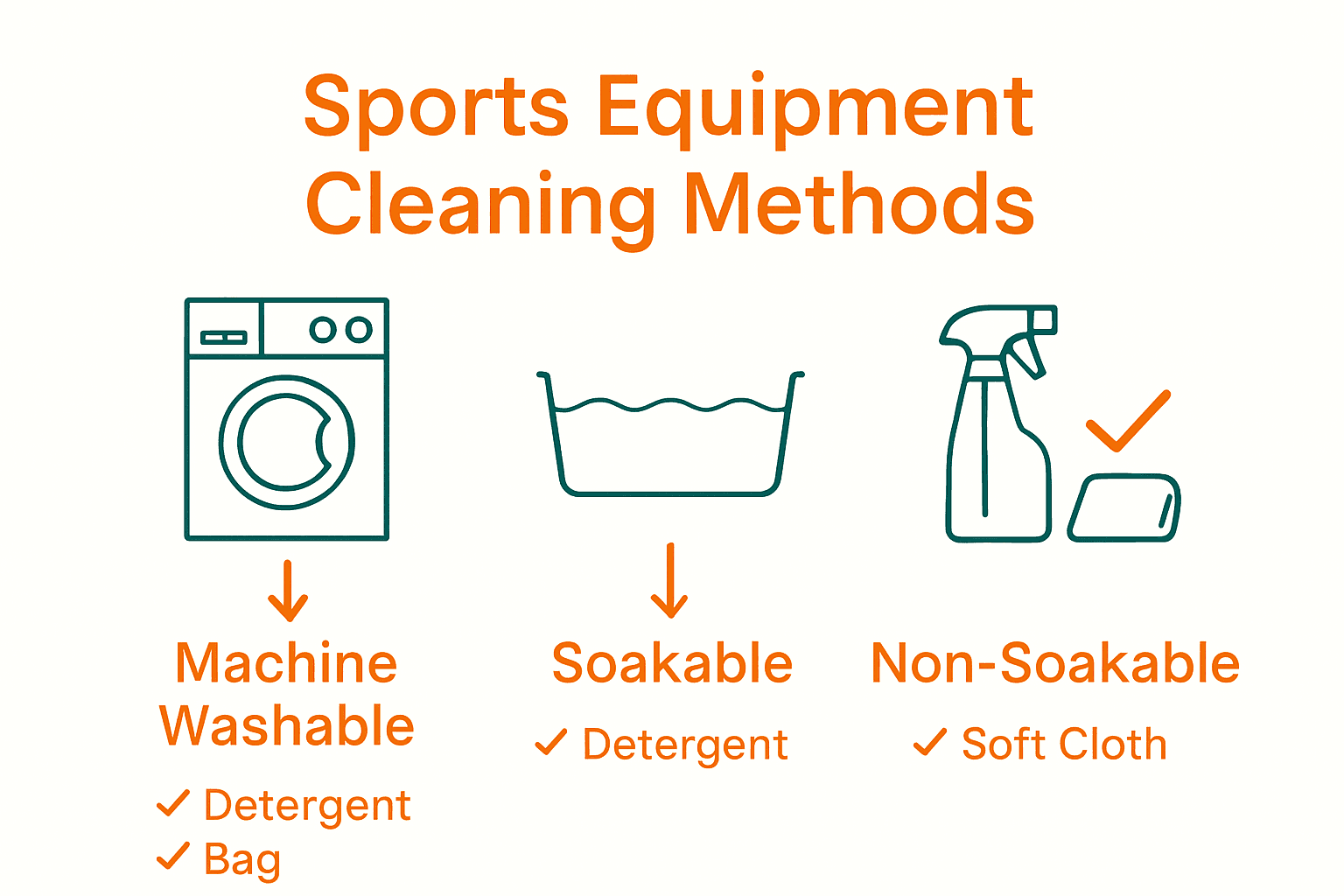Did you know that bacteria can double every twenty minutes on sweaty sports equipment? Caring for your gear does more than keep it looking good. It helps prevent odor, extends equipment life, and protects your health. With the right approach, you can tackle dirt, sweat, and stains without risking damage, ensuring every game or workout feels fresh and safe.
Quick Summary
| Key Point | Explanation |
|---|---|
| 1. Assess Equipment Type | Understand your gear types and conditions to choose the right cleaning methods. |
| 2. Gather Proper Supplies | Use specialized cleaning supplies suitable for different materials to avoid damage. |
| 3. Pre-Treat Stains | Address visible dirt and stains before washing to enhance cleanliness and hygiene. |
| 4. Wash According to Type | Follow specific washing instructions for each equipment type to preserve integrity. |
| 5. Dry Thoroughly and Inspect | Ensure proper drying and inspect for any remaining dirt or moisture to maintain quality. |
Table of Contents
- Step 1: Assess Equipment Type And Condition
- Step 2: Gather Suitable Cleaning Supplies
- Step 3: Pre-Treat Stains And Remove Debris
- Step 4: Wash Equipment Using Right Methods
- Step 5: Dry And Inspect For Thorough Cleanliness
Step 1: Assess Equipment Type and Condition
Before diving into cleaning your sports equipment, you need to play detective and understand exactly what you’re working with. Different pieces of sports gear are like unique personalities—each requires a specific approach to stay clean and in top shape.
Start by taking a thorough inventory of your equipment. According to cleaning experts, sports gear generally falls into three main categories: machine washable items, soakable gear, and non soakable equipment. Your tennis shorts? Probably machine washable. That delicate climbing harness? Might need a gentler touch.
Carefully inspect each item for its material composition and current condition. Look for visible dirt, potential wear and tear, or any special manufacturer instructions. Some equipment like climbing wall holds or specialized sports flooring demand specific cleaning methods that can vary dramatically. As research from professional cleaning guidelines suggests, alkaline detergents work great for climbing holds while sports hall floors might require specialized scrubber dryers.
Pro Tip: When in doubt about cleaning a piece of equipment, always check the manufacturer’s label or website for specific care instructions.
Your goal in this assessment phase is to create a mental map of cleaning strategies tailored to each piece of gear. By understanding the unique needs of your equipment, you’ll prevent potential damage and ensure thorough hygiene.
Ready to move on to the next cleaning step? Your detailed equipment assessment has set you up for success.
Here’s a summary of cleaning approaches by equipment type:

| Equipment Type | Cleaning Method | Recommended Supplies |
|---|---|---|
| Machine Washable Items | Machine wash (cold/warm) | Enzyme detergent Mesh bags |
| Soakable Gear | Hand wash/Soak in soapy water | Gentle detergent Baking soda |
| Non Soakable Equipment | Wipe with damp cloth/spray clean | Diluted cleaner Soft cloth |
| Specialized Surfaces | Unique methods (per guidelines) | Alkaline/acidic detergents Steam cleaner |
Step 2: Gather Suitable Cleaning Supplies
Now that you know exactly what equipment you’re dealing with, it is time to assemble your cleaning arsenal. Think of this like preparing for a mission where the right tools make all the difference between success and potential equipment damage.
Research suggests using specialized cleaning supplies that match your specific gear. According to cleaning experts, your toolkit should include versatile items like enzyme-based detergents which are fantastic for neutralizing stubborn odors. White vinegar is another secret weapon that works wonders for eliminating unwanted smells without harsh chemicals.
Prepare a collection of essential cleaning tools. Microfibre cloths are gentle yet effective for most surfaces, while soft brushes can help you tackle those hard-to-reach areas without scratching delicate equipment. Mesh laundry bags will be your best friend for machine-washable items, protecting them from unnecessary wear during the cleaning process.
Pro Tip: Always read equipment labels and avoid harsh chemicals that could potentially degrade your sports gear.
Different surfaces might require different approaches. As professional cleaning guidelines indicate, you might need alternating acidic and alkaline detergents for certain areas, and specialized tools like steam cleaners for deep sanitization.
Your carefully curated cleaning supplies are now ready. Next up? We will dive into the actual cleaning process with precision and care.

Step 3: Pre-Treat Stains and Remove Debris
Before diving into a full cleaning routine, you need to tackle the surface dirt and stubborn stains that have made your sports equipment their home. Think of this step as the preliminary battle against grime and bacterial buildup.
According to cleaning research, the first line of defense is removing coarse dirt and loose debris. As professional cleaning guidelines suggest, start by using surface cleaners or vacuums to eliminate loose particles. This prevents embedding contaminants deeper into your equipment during the washing process.
Pay special attention to those pesky sweat stains that can cause yellowing and unpleasant odors. According to expert recommendations, spot treating these areas before full washing is crucial. Use a targeted approach with enzyme-based detergents that break down protein-based stains effectively. For most gear, a gentle pre-treatment with a specialized cleaner can work wonders in restoring your equipment’s original condition.
Pro Tip: Always air and wipe your equipment immediately after use to prevent bacterial growth and make future cleaning easier.
For delicate items, use soft cloths or specialized brushes to gently remove surface dirt without causing damage. The key is being thorough yet gentle—you want to clean your equipment, not destroy it in the process.
With debris removed and stains pre-treated, you are now ready to move into the full cleaning phase. Your equipment is primed and prepared for a deep and effective wash.
Step 4: Wash Equipment Using Right Methods
With your equipment pre-treated and ready, it is time to dive into the actual cleaning process. Different types of sports gear demand unique washing approaches that will keep them in top condition without causing damage.
For textile items like workout clothes and jerseys, professional cleaning guidelines recommend machine washing at 30 degrees Celsius. According to experts, turn your garments inside out and place them in mesh laundry bags for added protection. Adding a splash of white vinegar or enzyme-based detergent can help neutralize odors and break down stubborn sweat stains.
Bulky or non machine washable items require a gentler touch. Hand washing in warm soapy water works wonderfully for these pieces. You might want to add a bit of baking soda or vinegar to the mix for extra cleaning power. For non soakable equipment like protective gear or delicate items, use a diluted detergent spray and a soft cloth to carefully wipe down surfaces.
Pro Tip: Always check manufacturer labels for specific washing instructions to avoid accidentally damaging your equipment.
For more specialized surfaces like gym floors or climbing equipment, professional cleaning research suggests unique approaches. Steam cleaning can effectively remove sweat and pathogens from gym surfaces without harsh chemicals. Climbing holds might benefit from alkaline detergents, while high touch surfaces should be thoroughly disinfected.
Your meticulous washing process is complete. Next, we will focus on drying and final preparation to ensure your sports equipment is fresh and ready for action.
Step 5: Dry and Inspect for Thorough Cleanliness
With washing complete, you are now entering the crucial final stages of sports equipment cleaning. This step is all about ensuring your gear is completely dry and thoroughly inspected to maintain its quality and prevent potential damage.
According to cleaning experts, air drying is your best friend. Resist the temptation to use a tumble dryer as this can damage fabrics and compromise the integrity of your equipment. Professional guidelines recommend hanging items in a well ventilated area away from direct sunlight. This prevents material damage and ensures a thorough drying process.
Inspection is key during this stage. As research from sports facility maintenance suggests, carefully examine each piece of equipment for any residual dirt, streaks, or moisture. Look closely at seams, folds, and hard-to-reach areas where moisture might hide. For textiles, check for any remaining stains or signs of wear. For harder surfaces like protective gear, ensure no cleaning residue remains.
Pro Tip: Hang non soakable gear out of direct sunlight to prevent material degradation and color fading.
Pay special attention to maintaining the functional quality of your equipment. Different materials require different drying approaches. Breathable fabrics need open air circulation, while leather or specialized gear might need specific care to prevent cracking or warping.
Your equipment is now clean, dry, and ready for its next athletic adventure. Proper maintenance like this extends the life of your gear and ensures top performance every time you use it.
Upgrade Your Sports Gear Cleaning Routine with DreamRamp.ro
Struggling to keep your sports equipment truly clean can be exhausting. Regular cleaning requires the right approach and reliable tools or you risk leaving behind hidden grime and odors that harm hygiene and shorten your gear’s lifespan. The article above highlights the importance of using proper products and techniques like enzyme detergents and careful drying. Yet many athletes waste time on labor-intensive cleaning and still get disappointing results.

Now is the perfect moment to make your cleaning routine easier and more effective. Discover the innovative cleaning appliances and accessories at DreamRamp.ro. You will find electric and manual mops, ergonomic buckets, powerful brushes, and smart cleaning sets that separate clean from dirty water. With our streamlined shopping experience and trusted product quality, you can boost hygiene, save time, and care for your valuable sports gear the way it deserves. Ready for fresher and safer play? Visit DreamRamp.ro, explore our range, and order your next cleaning ally today.
Frequently Asked Questions
How can I determine the best cleaning method for my sports equipment?
Start by assessing the type and condition of your equipment. Identify whether it is machine washable, soakable, or non-soakable, then choose the appropriate cleaning method based on this classification.
What kind of cleaning supplies should I gather for cleaning sports gear?
Assemble supplies like enzyme-based detergents, soft brushes, and microfiber cloths tailored to your equipment type. Ensure you have mesh laundry bags for machine-washable items to protect them during the wash cycle.
How do I pre-treat stains on my sports equipment effectively?
Use a targeted approach with enzyme-based detergents on sweat stains before washing. Apply the cleaner directly to the stain and allow it to sit for 5-10 minutes for optimal results, then proceed with your regular cleaning process.
What is the proper way to dry my sports gear after cleaning?
Always air dry your sports gear in a well-ventilated area away from direct sunlight to prevent damage. For textiles, hang them until fully dry, ensuring they get enough airflow, while keeping non-soakable items in a shaded spot.
How often should I clean my sports equipment for optimal hygiene?
Clean your sports equipment after every use or at least once a week, depending on the frequency of use. Regular cleaning helps reduce bacteria build-up and extends the life of your gear, promoting better hygiene.
Are there special considerations for cleaning delicate sports gear?
Yes, for delicate items, always refer to the manufacturer’s care instructions. Use soft cloths or specialized brushes to gently clean without causing damage, taking care to avoid any harsh chemicals or methods.









